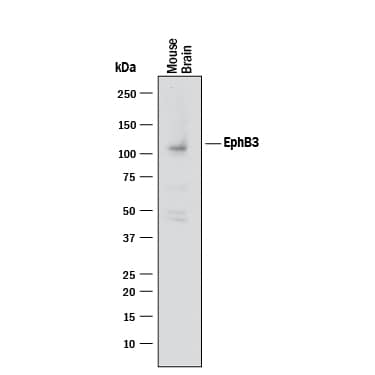Mouse EphB3 Antibody
R&D Systems, part of Bio-Techne | Catalog # AF432


Key Product Details
Species Reactivity
Validated:
Mouse
Cited:
Mouse
Applications
Validated:
CyTOF-ready, Flow Cytometry, Immunocytochemistry, Western Blot
Cited:
Flow Cytometry, Immunofluorescence, Immunohistochemistry, Immunohistochemistry-Frozen, Immunohistochemistry-Paraffin, Western Blot
Label
Unconjugated
Antibody Source
Polyclonal Goat IgG
Product Specifications
Immunogen
Mouse myeloma cell line NS0-derived recombinant mouse EphB3
Leu30-Thr537
Accession # P54754
Leu30-Thr537
Accession # P54754
Specificity
Detects mouse EphB3 in direct ELISAs and Western blots. In direct ELISAs, approximately 5% cross-reactivity with recombinant human EphB3 is observed and less than 1% cross-reactivity with recombinant rat EphB1, recombinant mouse (rm) EphA4, rmEphB2, rmEphB4, and rmEphB6 is observed.
Clonality
Polyclonal
Host
Goat
Isotype
IgG
Scientific Data Images for Mouse EphB3 Antibody
Detection of Mouse EphB3 by Western Blot.
Western blot shows lysates of mouse brain tissue. PVDF membrane was probed with 1 µg/mL of Goat Anti-Mouse EphB3 Antigen Affinity-purified Polyclonal Antibody (Catalog # AF432) followed by HRP-conjugated Anti-Goat IgG Secondary Antibody (Catalog # HAF017). A specific band was detected for EphB3 at approximately 130 kDa (as indicated). This experiment was conducted under reducing conditions and using Immunoblot Buffer Group 1.EphB3 in COLO 205 Human Cell Line.
EphB3 was detected in immersion fixed COLO 205 human colorectal adeno-carcinoma cell line using Goat Anti-Mouse EphB3 Antigen Affinity-purified Polyclonal Antibody (Catalog # AF432) at 10 µg/mL for 3 hours at room temperature. Cells were stained using the NorthernLights™ 557-conjugated Anti-Goat IgG Secondary Antibody (yellow; Catalog # NL001) and counter-stained with DAPI (blue). View our protocol for Fluorescent ICC Staining of Cells on Coverslips.Applications for Mouse EphB3 Antibody
Application
Recommended Usage
CyTOF-ready
Ready to be labeled using established conjugation methods. No BSA or other carrier proteins that could interfere with conjugation.
Flow Cytometry
2.5 µg/106 cells
Sample: COLO 205 human colorectal adenocarcinoma cell line
Sample: COLO 205 human colorectal adenocarcinoma cell line
Immunocytochemistry
5-15 µg/mL
Sample: Immersion fixed COLO 205 human colorectal adenocarcinoma cell line
Sample: Immersion fixed COLO 205 human colorectal adenocarcinoma cell line
Western Blot
1 µg/mL
Sample: Mouse brain tissue
Sample: Mouse brain tissue
Formulation, Preparation, and Storage
Purification
Antigen Affinity-purified
Reconstitution
Reconstitute at 0.2 mg/mL in sterile PBS. For liquid material, refer to CoA for concentration.
Formulation
Lyophilized from a 0.2 μm filtered solution in PBS with Trehalose. *Small pack size (SP) is supplied either lyophilized or as a 0.2 µm filtered solution in PBS.
Shipping
Lyophilized product is shipped at ambient temperature. Liquid small pack size (-SP) is shipped with polar packs. Upon receipt, store immediately at the temperature recommended below.
Stability & Storage
Use a manual defrost freezer and avoid repeated freeze-thaw cycles.
- 12 months from date of receipt, -20 to -70 °C as supplied.
- 1 month, 2 to 8 °C under sterile conditions after reconstitution.
- 6 months, -20 to -70 °C under sterile conditions after reconstitution.
Background: EphB3
References
- Pasquale, E.B. (2008) Cell 133:38.
- Ruiz, J.C. et al. (1994) Mech. Dev. 48:153.
- Pasquale, E.B (2004) Nat. Neurosci. 7:417.
- Trivier, E. and T.S. Ganesan (2002) J. Biol. Chem. 277:23037.
- Miao, H. et al. (2005) J. Biol. Chem. 280:923.
- Adams, R.H. et al. (1999) Genes Dev. 13:295.
- Krull, C.E. et al. (1997) Curr. Biol. 7:571.
- Willson, C.A. et al. (2006) J. Mol. Histol. 37:369.
- Cortina, C. et al. (2007) Nature Genet. 39:1376.
- Birgbauer, E. et al. (2000) Development 127:1231.
- Alfaro, D. et al. (2008) Immunology 125:131.
- Risley, M. et al. (2009) Mech. Dev. 126:230.
- Liu, X. et al. (2006) J. Neurosci. 26:3087.
- Batlle, E. et al. (2005) Nature 435:1126.
- Holmberg, J. et al. (2006) Cell 125:1151.
Long Name
Eph Receptor B3
Alternate Names
Cek10, Hek2, Mdk5, Sek4, Tyro6
Gene Symbol
EPHB3
UniProt
Additional EphB3 Products
Product Documents for Mouse EphB3 Antibody
Product Specific Notices for Mouse EphB3 Antibody
For research use only
